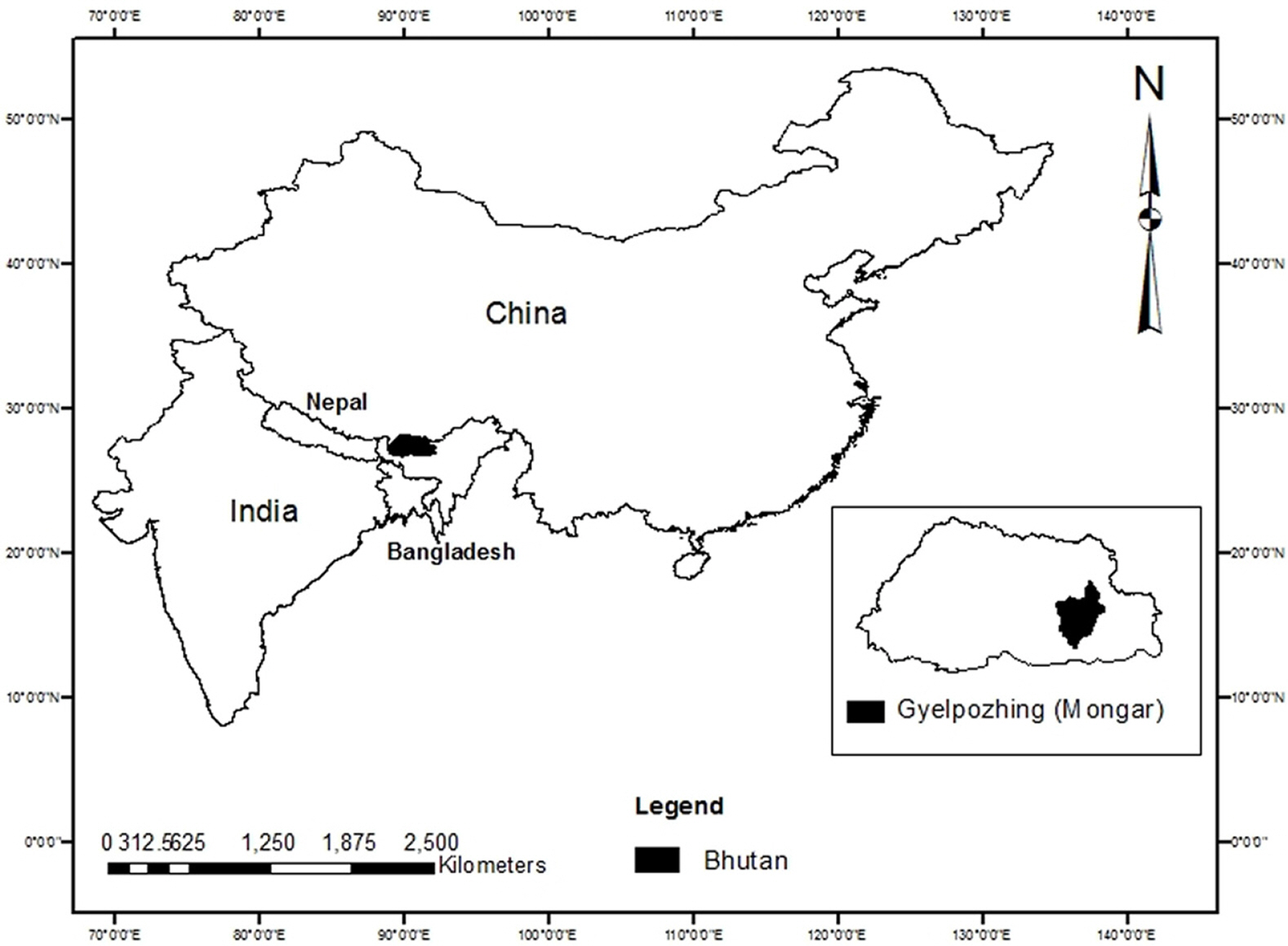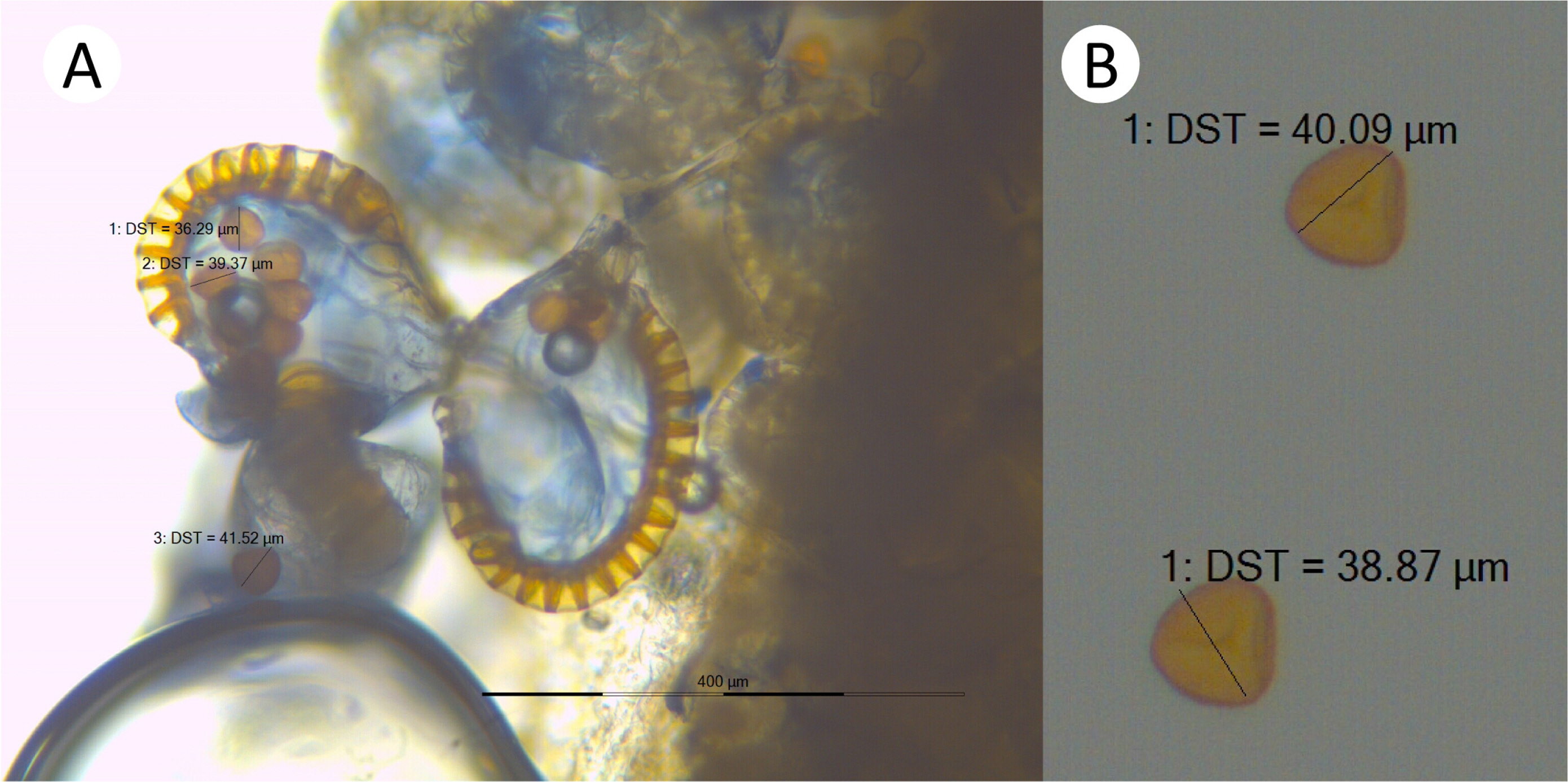The first record of the rare fern Pteris griffithii (Polypodiales: Pteridaceae: Pteridoideae) in the Bhutan Himalayas
Article information
Abstract
Pteris griffithii Hook., one of the rarest fern species on the Indian subcontinent, is reported from Bhutan for the first time. The identity of this species was confirmed through morphological determination at the National Herbarium (THIM) of the National Biodiversity Centre (NBC) of Bhutan. It was found only in one location, in Gyelpozhing in eastern Bhutan, at an elevation of 521 m a.s.l. on 10 January 2016. Given that a very limited study of this species was conducted, the knowledge baseline with regard to its distribution is poor. It is also reported that this species has not been found for several years. The species is also considered to be very rare or critically endangered in some countries; however, there are no assessments on the International Union for Conservation of Nature (IUCN) Red List for this particular species. This paper attempts to provide baseline information considering its rarity and data deficiency. This species is also reported from the adjacent neighboring Indian state of Arunachal Pradesh as very rare, and also from Myanmar; however, confirmation of its presence in China is not clear at this time. Therefore, considering its data deficient status, we attempt to document it scientifically to create a knowledgebase pertaining to this particular species. Concurrently, this species merits further research to understand its distribution patterns in Bhutan and any related anthropogenic threats.
INTRODUCTION
Bhutan lies between China and India, with the lowest elevation at 97 m a.s.l. (above sea level) in southern Bhutan and the highest peak, Gangkhar Phuensum rises to 7,570 m a.s.l. The Bhutanese Himalayan regions us a part of one of the biodiversity hotspots in the world, the Eastern Himalayas (National Biodiversity Centre, 2019). The country is well bestowed with diverse flora and fauna with new species discovered almost every year, despite being a small country with lower taxonomic studies (Gyeltshen et al., 2018). Studies on some of the groups are well studied, such as mammals, flowering plants, and birds; however, the study on pteridophytes (ferns and lycophytes) are still remain understudied. Thus, not much information is available in Bhutan on Pteris griffithii Hook. and other pteridophytes in general.
One-third of the world’s pteridophytes diversity around 4,500 species is found in Southeast Asia, and among these 101 threatened pteridophytes species occurs in South Asia (Ebihara et al., 2012). Fraser-Jenkins et al. (2009) attempted to develop checklist on pteridophytes of Bhutan, of which 411 species of pteridophytes are reported. The checklist consists of 27 families and 88 genera. More number of pteridophytes species are expected to occur in Bhutan since not many studies have been carried out since Fraser-Jenkins et al. (2009), although few small-scale types of research have been conducted as a part of bachelors thesis (Dorji, 2016). However, in the checklist developed by Fraser-Jenkins et al. (2009), he reported a new species Asplenium rebeccae Fraser-Jenk. & Wangdi and a new natural hybrid Asplenium × tandinii Fraser-Jenk., which appears to be an unresolved name. Likewise, Asplenium rebeccae is not established either as an accepted name or as a synonym. Similarly, Asplenium × tandinii Fraser-Jenk., which is assumed to be hybrid of Asplenium rebeccae Fraser-Jenk. × Asplenium laciniatum D. Don subsp. tenuicaule (Hayata) Fraser-Jenk., is also not an accepted name or a synonym (The Plant List, 2018; Catalogue of Life, 2018; Global Biodiversity Information Facility, 2017; Fraser-Jenkins, 2008). Thus, the number of fern species reported by Fraser-Jenkins et al. (2009) may be reduced to 409.
The genus Pteris consists of around 300 species of ferns around the world belonging to subfamily Pteridoideae and family Pteridaceae (Kamau, 2012). In Bhutan, there are 10 genera and 59 species of Pteris. Pteris griffithii is mostly distributed in India (Arunachal Pradesh), Myanmar, China, and now in Bhutan (Fig. 1). However, the occurrence of Pteris griffithii in China, Andaman and Nicobar Islands (India), and Bangladesh is still doubtful and possibly an error (Fraser-Jenkins, 2012). near Gyelpozhing. D. Herbarium specimen deposited at the National Herbarium of Bhutan (THIM), National Biodiversity Centre, Thimphu.
MATERIALS AND METHODS
The herbarium specimens of P. griffithii were collected in Bhutan on 10 January 2016. This species has not been recollected for many years in India (Chandra et al., 2008). Thus meriting further investigation as the species is not known for many years with limited information. The species is found only in one location at Gyelpozhing in eastern Bhutan (Fig. 2) at an altitude of 521 m a.s.l. by the first author. Gyelpozhing is located 30 km from the Mongar town in Mongar Dzongkhag (District). Gyelpozhing is dominated by chirpine forest partially mixed with broad-leaved forest falling under the subtropical and temperate zonation of Bhutan. Maximum temperature recorded was 24°C and minimum temperature at 5°C. The highest monthly rainfall was recorded at 268 mm, while there was no record of rainfall at all (0 mm), especially in December and January (National Statistics Bureau, 2011), which remains completely dry undergrowth except for lemongrass at harvesting stage.
An attempt was made to discover more populations of this species along with the similar altitude and habitat around the region. Similar altitude (± 200 m a.s.l.) and habitats were used as transact line. However, we could not find any more population in other locations. Assessments to confirm the species as rare/critically endangered and new record has been carried out based on the fieldworks, literature, and herbarium collections.
Ex-situ conservation of Pteris griffithii
The location and the habitat of this species is very critical. The species was observed in a very vulnerable location within the water accumulation damn of the electricity hydro project. The species is grown only on one spot. The species was observed during winter season where the water level drops. The species was growing nearby river connected to hydro project damn. The species prefer to grow in sandy soil in between the boulders. During the summer seasons, the water level goes up and the river bank gets submerged including all those plants which grow nearby river bank. It indicates that the species can grow only in winter seasons where the water level goes down and finds the suitable site to grow.
The ex-situ work for this species was done to rescue from getting submerged by the water during summer season. Usually, the species grows in clump size and as the clump of this species was not in more numbers. About 10 clumps have been rescued using plastic polythene bag and transferred to Orchid House of the Royal Botanical Garden, Serbithang in Thimphu, Bhutan. However, the altitude level of origin habitat of this species is different from the place where it was relocated in different altitude range. But it was replanted in orchid house where the temperature in the house is maintained as similar to the weather of original habitat of this species. The survival rate of the species was poor and only one clump survived out of 10 clumps. The minimum temperature of orchid house in winter is a minimum of 5°C and the temperature is maintained artificially by using blower electric heater. The requirement of warm temperature in the Orchid House is very necessary for the orchid and also for those plants which need more moisture content. The requirement of moisture for this species is favorable in the orchid house and it is maintained throughout the winter. But the survival of this species resulted in poor form.
RESULTS AND DISCUSSION
Family: Pteridaceae
Subfamily: Pteridoideae
Pteris griffithii Hook., Sp. Fil. 2: 170, t. 123A, 1853.— TYPE: INDIA. Arunachal Pradesh, 1867, William Griffith (holotype: K, K001057864) (Figs. 1, 3)
Plants terrestrial, 60 cm tall or more. Rhizomes partially short creeping, partly open from sandy surface; rhizomes hairs brown to brown-black. Leaves dark greenish, to 37 cm long. Petiole whitish brown, 3–24 cm, connecting to rhizomes, basally scaly, scales slightly whitish brown, seta hairy. Blade bi-pinnate; stalk within the blade attached to each pinnae, separate from mid-rib, scales white, hairy; pinnae free, opposite, 5–9 pairs, 1.1–2.1 cm, pinnae stalks 0.5–9 mm; pinnules are not divided, 1–3.5 cm. Veins anastomosing without included veins, free to leaf margin. Fertile fronds bearing sori; sori marginal in ultimate segments. Spores 36.29 × 41.52 μm.
Distribution: Bhutan, India (Arunachal Pradesh), Myanmar (Fraser-Jenkins, 2012).
Specimens examined: BHUTAN. Gyelpozhing, Mongar District, elev. 521 m; 27°15.02′N, 91°11.02′E. 10 Jan 2016, R. Dorji 102 (THIM); MYANMAR. Tamu, elev. 304 m; 21 Nov 1938, F. Kingdon-Ward 10, (GH, GH00277330); INDIA. Assam, (BM, BM001044194).
Seven herbarium specimens were also collected on 10 January 2016 by Rinchen Dorji with the collection number of 102 (Fig. 1D) were deposited at the National Herbarium (THIM) of National Biodiversity Centre, Serbithang, Thimphu, Bhutan. Live stocks are also collected and replanted in Orchid House.
Reassessment of Pteris griffithii in its habitat
Reassessment of species was carried out in the following year to see any survival in the same habitat. Every year during the winter season, when the water level of the project dam is low, the species habitat was under observation to see any sign of regrowth. Yet from the final survey in the same habitat during the winter of 2021, 18 clumps from 15 clumps of P. griffithii reappeared at the same spot. The number of clumps has been increased compared to the last observation when the species was seen for the first time in the year 2016. It indicates that the growth of species in the same habitat will continue unless if there is habitat destruction by any interference.
This is the first confirmed record of Pteris griffithii in Bhutan. The species was found growing along the riverbank, in sandy habitat between the boulders (Fig. 6). Upon survey of this species around Bhutan, this species was found only in one location in Gyelpozhing, Mongar District. No other records of this species in Bhutan were observed by the authors in the fields, literatures accessible to the authors, specimens, online data portals (e.g., Bhutan Biodiversity Portal, http://www.biodiversity.bt, GBIF). Thus, we assume this species to be very rare, and it merits further Red List assessments. However, P. griffithii is reported as Critically Endangered in India by Chandra et al. (2008), and Fraser-Jenkins (2012) reported this species as very rare. International Union for Conservation of Nature list this species as data deficient. In Bhutan, this species lack assessments; thus, we cannot confirm it as threatened; however, we would consider this species is very rare since the species was located only from one location in Bhutan with around 18 clumps.
Acknowledgements
We cordially thank Dr. Tashi Yangzome Dorji, former Program Director, and Dr. Karma Dema Dorji, current Program Director, NBC, for her constant motivation and guidance. The authors would like to thank Dr. Christopher Roy Fraser-Jenkins, Nepal and Dr. Atsushi Ebihara, National Museum of Nature and Sciences, Japan for the technical input of the study. We are also grateful to Ms. Danielle Northey, volunteer at NBC for her language review. Our heartfelt gratitude goes to the editors and anonymous reviews of this article. We thank National Biodiversity Centre, Thimphu for the financial support to conduct field trips.
Notes
CONFLICTS OF INTEREST
The authors declare that there are no conflicts of interest.



